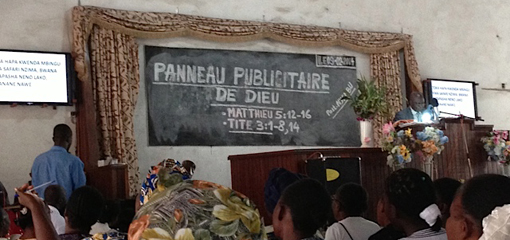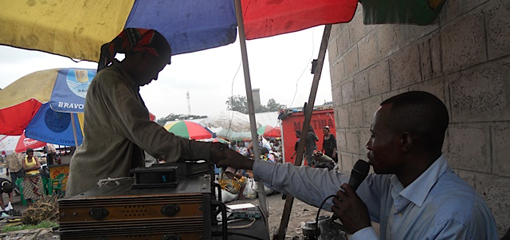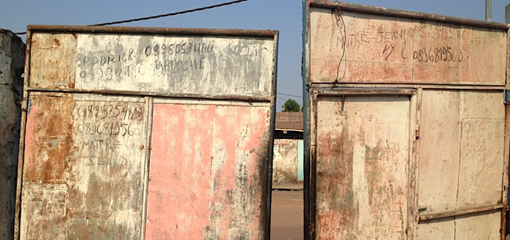This is a study by Dr Katrien Pype of communicative formations in Kinshasa since 1960. It has distinguishable concrete and abstract objectives.

Concrete objectives
- To research communicative spaces in Kinshasa since Independence by analysing how and where people interact(ed);
- Which technologies Kinois (Kinshasa’s inhabitants) have used to transmit and receive messages, information, and communicate public and private opinions;
- How cultural parameters of age, gender, religion, ethnicity and class that shape local approaches to privacy, authority, and distribution of speech have varyingly influenced Kinois’ resort to media such as written letters, telegrams, fixed-line and mobile telephones, smartphones, Internet, etc.
- How the technologically mediated distribution of information interacts with other ways of managing, sharing (or withholding) news, data, and knowledge , e.g. gossip and rumours, taboos, or conventions confining the discussion of controversial, intimate, and political subjects to particular speech and literary genres.
Abstract objectives
To contribute to the field of urban anthropology by analysing the dialectics between technology and society and answering two key questions:
- To what extent do communication technologies shape the urban experience in Central Africa?
- What social, cultural and political parameters determine communication in Central African cities, and how do these operate?

Context
Kinshasa, which has grown continuously since the early postcolonial period, is ideal for exploring interactions between technology, culture and society. Today a megacity of some eight million, it is a privileged 'laboratory' for studying how urban inhabitants connect both with each other and with those 'elsewhere' (in 'the village', other parts of Africa, and in 'the West'). Kinshasa’s dramatic political history - with its on-going experiences of censorship (Frère 2007), including government control of broadcast media in the Mobutu era and the shutting down of the text messaging system in December 2011 - is a window on the nexus between politics, urbanity and communication. The installation of new communication infrastructures since 1960 has expanded and constrained how Kinois express themselves and channel political opinions.
These post-Independence changes build on technologies introduced under colonialism. Public radio broadcasters, television technology, telegraph systems and fixed landlines were the main technological channels of official information, linking administrators in the colony’s capital to the hinterland and the metropole, and city dwellers to each other. As in many other African countries, meanings ascribed to communication infrastructure far exceeded the facilitation of information across distances. Officials believed the material infrastructure and the possibilities of non-face-to-face communication would invoke awe of colonial technological superiority and the 'Western sublime' (Larkin 2008). For the colonized, access to these new technologies was difficult. Only évolués, a distinct group of Congolese trained according to Western 'civilisatory rules', were supposed to be able to master these technologies. Radio sets and telephones quickly became tokens of and indispensable tools in their 'western' and 'modern' lifestyle. Moreover, various kinds of human and technological intermediaries - e.g. amanuenses and typewriters - merged évolués into less literate but larger social networks.
Since Independence, politics and technology have significantly altered the communicative landscape. First, postcolonial governments have not invested much in public infrastructure, leading to a gradual deterioration of landlines and state broadcasting facilities. This encouraged private companies to invest in the maintenance and innovation of communication technologies; e.g. private telegraph companies (phonie houses) started flourishing and informal ways of circulating letters have replaced post offices took over. Second, the gradual 'democratization' of technologies like radio and television sets, and later mobile phones, has seen increasing importation of these goods by traders and travellers. Third, incessant technological innovation (e.g. smartphones) has led to new ways of conversing, reaching out to others, and of expression.
These changes alter the material urban landscape (post offices, telegraph lines, public television sets, cellular antennae, cybercafés); generate new urban publics who converse about city life, the nation, and the global; and mediate in distinct ways movements of people, ideas, commodities and money. These phenomena, although not unique to Kinshasa, have never been studied from an anthropological perspective. Therefore, the proposed programme is highly unique.
Located at the intersections of urban anthropology, the study of popular culture, and anthropology of technology, this project is innovative conceptually and empirically within African Studies, while also contributing to comparative research on public cultures and large-city environments. The findings will be of interest to anyone working on one or more of the following fields: urban studies; media and communication; science, technology and society (STS); and cultural studies.
